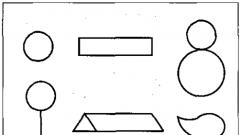Lightning is a natural phenomenon. Types of lightning: linear, intracloud, ground
Lightning 1882
(c) Photographer: William N. Jennings, c. 1882
The electrical nature of lightning was revealed in the research of the American physicist B. Franklin, on the basis of which an experiment was carried out to extract electricity from a thundercloud. Franklin's experience in elucidating the electrical nature of lightning is widely known. In 1750, he published a work describing an experiment using a kite launched into a thunderstorm. Franklin's experience was described in the work of Joseph Priestley.
Physical properties of lightning
The average lightning length is 2.5 km, some discharges extend in the atmosphere for a distance of up to 20 km.
lightning formation
Most often lightning occurs in cumulonimbus clouds, then they are called thunderclouds; sometimes lightning is formed in nimbostratus clouds, as well as during volcanic eruptions, tornadoes and dust storms.
Linear lightnings are usually observed, which belong to the so-called electrodeless discharges, since they begin (and end) in clusters of charged particles. This determines some of their still unexplained properties that distinguish lightning from discharges between electrodes. So, lightning is not shorter than a few hundred meters; they arise in electric fields much weaker than the fields during interelectrode discharges; The collection of charges carried by lightning occurs in thousandths of a second from billions of small, well-isolated particles located in a volume of several km³. The process of development of lightning in thunderclouds is the most studied, while lightning can take place in the clouds themselves - intracloud lightning, but they can hit the ground - ground lightning. For lightning to occur, it is necessary that in a relatively small (but not less than some critical) volume of the cloud an electric field (see atmospheric electricity) be formed with a strength sufficient to start an electric discharge (~ 1 MV / m), and in a significant part of the cloud there would be a field with an average strength sufficient to maintain the discharge that has begun (~ 0.1-0.2 MV / m). In lightning, the electrical energy of the cloud is converted into heat, light and sound.
ground lightning
The process of ground lightning development consists of several stages. At the first stage, in the zone where the electric field reaches a critical value, impact ionization begins, created initially by free charges, always present in a small amount in the air, which, under the action of an electric field, acquire significant velocities towards the ground and, colliding with the molecules that make up air, ionize them.
According to more modern concepts, the ionization of the atmosphere for the passage of a discharge occurs under the influence of high-energy cosmic radiation - particles with energies of 10 12 -10 15 eV, forming a broad air shower (EAS) with a decrease in the breakdown voltage of air by an order of magnitude from that under normal conditions.
According to one hypothesis, the particles trigger a process called runaway breakdown. Thus, electron avalanches arise, turning into threads of electrical discharges - streamers, which are well-conducting channels, which, merging, give rise to a bright thermally ionized channel with high conductivity - stepped lightning leader.
The movement of the leader to the earth's surface occurs steps several tens of meters at a speed of ~ 50,000 kilometers per second, after which its movement stops for several tens of microseconds, and the glow is greatly weakened; then, in the subsequent stage, the leader again advances several tens of meters. At the same time, a bright glow covers all the steps passed; then a stop and a weakening of the glow follow again. These processes are repeated when the leader moves to the surface of the earth at an average speed of 200,000 meters per second.
As the leader moves towards the ground, the field strength at its end increases and under its action, response streamer, connecting to the leader. This feature of lightning is used to create a lightning rod.
In the final stage, the channel ionized by the leader is followed by back(bottom to top), or main, lightning discharge, characterized by currents from tens to hundreds of thousands of amperes, brightness, significantly exceeding the brightness of the leader, and a high speed of advance, at first reaching ~ 100,000 kilometers per second, and at the end decreasing to ~ 10,000 kilometers per second. The channel temperature during the main discharge can exceed 2000-3000 °C. The length of the lightning channel can be from 1 to 10 km, the diameter is several centimeters. After the passage of the current pulse, the ionization of the channel and its glow weaken. In the final stage, the lightning current can last hundredths and even tenths of a second, reaching hundreds and thousands of amperes. Such lightning is called protracted, they most often cause fires. But the earth is not charged, so it is generally accepted that the lightning discharge comes from the cloud towards the earth (from top to bottom).
The main discharge often discharges only part of the cloud. Charges located at high altitudes can give rise to a new (arrow-shaped) leader moving continuously at a speed of thousands of kilometers per second. The brightness of its glow is close to the brightness of the stepped leader. When the swept leader reaches the surface of the earth, a second main blow follows, similar to the first. Lightning usually includes several repeated discharges, but their number can reach up to several dozen. The duration of multiple lightning can exceed 1 second. The displacement of the channel of multiple lightning by the wind creates the so-called ribbon lightning - a luminous stripe.
Intracloud lightning
Intracloud lightning over Toulouse, France. 2006
Intracloud lightning usually includes only leader stages; their length varies from 1 to 150 km. The share of intracloud lightning increases with the shift to the equator, changing from 0.5 in temperate latitudes to 0.9 in the equatorial strip. The passage of lightning is accompanied by changes in electric and magnetic fields and radio emission, the so-called atmospherics.

Flight from Kolkata to Mumbai.
The probability of a ground object being struck by lightning increases as its height increases and with an increase in the electrical conductivity of the soil on the surface or at a certain depth (the action of a lightning rod is based on these factors). If there is an electric field in the cloud that is sufficient to maintain the discharge, but not enough to cause it to occur, a long metal cable or an airplane can play the role of the lightning initiator - especially if it is highly electrically charged. Thus, lightning is sometimes "provoked" in nimbostratus and powerful cumulus clouds.
Lightning in the upper atmosphere
In 1989, a special type of lightning was discovered - elves, lightning in the upper atmosphere. In 1995, another type of lightning in the upper atmosphere was discovered - jets.
elves
Jets
Jets are blue tubes. The height of jets can reach 40-70 km (lower boundary of the ionosphere), jets live relatively longer than elves.
Sprites
Sprites are difficult to distinguish, but they appear in almost any thunderstorm at an altitude of 55 to 130 kilometers (the height of the formation of "ordinary" lightning is no more than 16 kilometers). This is a kind of lightning that shoots up from the cloud. For the first time this phenomenon was recorded in 1989 by accident. Very little is known about the physical nature of sprites.
The interaction of lightning with the surface of the earth and objects located on it

Global frequency of lightning strikes (scale shows the number of strikes per year per square kilometer)
According to early estimates, the frequency of lightning strikes on Earth is 100 times per second. According to modern data from satellites that can detect lightning in places where there is no ground observation, this frequency is on average 44 ± 5 times per second, which corresponds to about 1.4 billion lightning strikes per year. 75% of these lightnings strike between clouds or within clouds, and 25% strike the ground.
The most powerful lightnings cause the birth of fulgurites.
Shockwave from lightning
A lightning discharge is an electrical explosion and is similar in some aspects to a detonation. It causes the appearance of a shock wave, dangerous in the immediate vicinity. A shock wave from a sufficiently powerful lightning discharge at distances of up to several meters can cause destruction, break trees, injure and concuss people even without direct electric shock. For example, at a current rise rate of 30 thousand amperes per 0.1 millisecond and a channel diameter of 10 cm, the following shock wave pressures can be observed:
- at a distance from the center of 5 cm (border of the luminous lightning channel) - 0.93 MPa,
- at a distance of 0.5 m - 0.025 MPa (destruction of fragile building structures and human injury),
- at a distance of 5 m - 0.002 MPa (glass breaking and temporary stunning of a person).
At greater distances, the shock wave degenerates into a sound wave - thunder.
people and lightning
Lightning is a serious threat to human life. The defeat of a person or animal by lightning often occurs in open spaces, since the electric current travels along the shortest path "thundercloud-ground". Lightning often hits trees and transformer installations on the railway, causing them to ignite. It is impossible to be struck by ordinary linear lightning inside a building, but there is an opinion that the so-called ball lightning can penetrate through cracks and open windows. Ordinary lightning is dangerous for television and radio antennas located on the roofs of high-rise buildings, as well as for network equipment.
In the body of the victims, the same pathological changes are noted as in case of electric shock. The victim loses consciousness, falls, convulsions may occur, breathing and heartbeat often stop. On the body, you can usually find "current marks", the points of entry and exit of electricity. In the event of a fatal outcome, the cause of the cessation of basic vital functions is a sudden cessation of breathing and heartbeat, from the direct action of lightning on the respiratory and vasomotor centers of the medulla oblongata. So-called signs of lightning often remain on the skin, tree-like light pink or red stripes that disappear when pressed with fingers (they remain for 1-2 days after death). They are the result of expansion of capillaries in the zone of lightning contact with the body.
Lightning travels in a tree trunk along the path of least electrical resistance, with the release of a large amount of heat, turning water into steam, which splits the trunk of a tree or more often tears off sections of bark from it, showing the path of lightning. In subsequent seasons, the trees usually regenerate damaged tissue and may close the entire wound, leaving only a vertical scar. If the damage is too severe, wind and pests will eventually kill the tree. Trees are natural lightning rods, and are known to provide lightning protection for nearby buildings. Planted near the building, tall trees trap lightning, and the high biomass of the root system helps to ground the lightning strike.
For this reason, you can not hide from the rain under the trees during a thunderstorm, especially under tall or single trees in open areas.
From trees struck by lightning, musical instruments are made, attributing to them unique properties.
Lightning and electrical installations
Lightning strikes are a major hazard to electrical and electronic equipment. With a direct lightning strike into the wires, an overvoltage occurs in the line, causing the destruction of the insulation of electrical equipment, and high currents cause thermal damage to the conductors. To protect against lightning surges, electrical substations and distribution networks are equipped with various types of protective equipment such as arresters, non-linear surge suppressors, long-spark arresters. Lightning rods and ground wires are used to protect against a direct lightning strike. For electronic devices, the electromagnetic pulse created by lightning is also dangerous.
Lightning and aviation
Atmospheric electricity in general and lightning in particular pose a significant threat to aviation. A lightning strike into an aircraft causes a large current to flow through its structural elements, which can cause their destruction, fire in fuel tanks, equipment failures, and death of people. To reduce the risk, the metal elements of the outer skin of aircraft are carefully electrically connected to each other, and non-metallic elements are metallized. Thus, a low electrical resistance of the case is ensured. To drain the lightning current and other atmospheric electricity from the hull, aircraft are equipped with arresters.
Due to the fact that the electric capacitance of an aircraft in the air is small, the "cloud-aircraft" discharge has a significantly lower energy compared to the "cloud-ground" discharge. Lightning is most dangerous for a low-flying aircraft or helicopter, since in this case the aircraft can play the role of a lightning current conductor from the cloud to the ground. It is known that aircraft at high altitudes are relatively often struck by lightning, and yet, cases of accidents for this reason are rare. At the same time, there are a lot of cases of aircraft being struck by lightning during takeoff and landing, as well as in the parking lot, which ended in disasters or the destruction of the aircraft.
Lightning and surface ships
Lightning also poses a very great threat to surface ships in view of the fact that the latter are elevated above the sea surface and have many sharp elements (masts, antennas), which are electric field strength concentrators. In the days of wooden sailboats with high hull resistivity, a lightning strike almost always ended tragically for the ship: the ship burned or collapsed, people died from electric shock. Riveted steel ships were also vulnerable to lightning. The high resistivity of the rivet joints caused significant local heat generation, which led to the occurrence of an electric arc, fires, destruction of the rivets and the appearance of water leakage of the case.
The welded hull of modern ships has a low resistivity and ensures safe spreading of the lightning current. The protruding elements of the superstructure of modern ships are reliably electrically connected to the hull and also ensure the safe spreading of the lightning current.
Human activity causing lightning
In a ground-based nuclear explosion, a fraction of a second before the arrival of the boundary of the fiery hemisphere a few hundred meters (~ 400-700 m when compared with an explosion of 10.4 Mt) from the center, the gamma radiation that has reached the center produces an electromagnetic pulse with a strength of ~ 100-1000 kV / m, causing discharges of lightning, striking from the ground up before the arrival of the border of the fiery hemisphere.
see also
| lightning in Wiktionary | |
| Category:Lightning at Wikimedia Commons |
Notes
- Ermakov V.I., Stozhkov Yu.I. Physics of thunderclouds // Fiz. P.N. Lebedev, RAS, M.2004: 37
- Cosmic rays blamed for lightning Lenta.ru, 09.02.2009
- Red Elves and Blue Jets
- ELVES, a primer: Ionospheric Heating By the Electromagnetic Pulses from Lightning
- Fractal Models of Blue Jets, Blue Starters Show Similarity, Differences to Red Sprites
- V.P. Pasko, M.A. Stanley, J.D. Matthews, U.S. Inan, and T.G. Wood (March 14, 2002) "Electrical discharge from a thundercloud top to the lower ionosphere," Nature, vol. 416, pages 152-154.
- The appearance of UFOs was explained by sprites. lenta.ru (24.02.2009). Archived from the original on August 23, 2011. Retrieved January 16, 2010.
- John E. Oliver Encyclopedia of World Climatology. - National Oceanic and Atmospheric Administration, 2005. - ISBN 978-1-4020-3264-6
- . National Oceanic and Atmospheric Administration. archived
- . NASA Science. science news. (December 5, 2001). Archived from the original on August 23, 2011. Retrieved April 15, 2011.
- K. BOGDANOV "LIGHTNING: MORE QUESTIONS THAN ANSWERS". "Science and Life" No. 2, 2007
- Zhivlyuk Yu.N., Mandelstam S.L. On the temperature of lightning and the strength of thunder // ZhETF. 1961. Vol. 40, no. 2. S. 483-487.
- N. A. Kun "Legends and Myths of Ancient Greece" LLC "AST Publishing House" 2005-538, p. ISBN 5-17-005305-3 pp. 35-36.
How many types of lightning are there in reality? It turns out that there are more than ten species, and the most interesting of them are given in this article. Naturally, there are not only bare facts here, but also real photographs of real lightning.
So, the types of lightning will be considered in order, from the most common linear lightning to the rarest sprite lightning. Each type of lightning is given one or more photos that help to understand what such lightning really is.
L frost lightning (cloud-earth)
How to get such lightning? Yes, it's very simple - all that is required is a couple of hundred cubic kilometers of air, a height sufficient for the formation of lightning and a powerful heat engine - well, for example, the Earth. Ready? Now take the air and sequentially begin to heat it. When it starts to rise, with each meter of rise, the heated air cools, gradually becoming colder and colder. Water condenses into ever larger droplets, forming thunderclouds. Remember those dark clouds above the horizon, at the sight of which the birds fall silent and the trees stop rustling? So, these are the thunderclouds that give rise to lightning and thunder.
Scientists believe that lightning is formed as a result of the distribution of electrons in the cloud, usually positively charged from the top of the cloud, and negatively from. The result is a very powerful capacitor that can be discharged from time to time as a result of the abrupt transformation of ordinary air into plasma (this is due to the increasingly strong ionization of atmospheric layers close to thunderclouds). Plasma forms peculiar channels, which, when connected to the ground, serve as an excellent conductor for electricity. Clouds are constantly discharged through these channels, and we see the external manifestations of these atmospheric phenomena in the form of lightning.
By the way, the air temperature in the place where the charge (lightning) passes reaches 30 thousand degrees, and the speed of lightning propagation is 200 thousand kilometers per hour. In general, a few lightning bolts were enough to power a small town for several months.
And there are such lightning. They are formed as a result of the accumulating electrostatic charge on top of the tallest object on earth, which makes it very "attractive" for lightning. Such lightnings are formed as a result of "piercing" the air gap between the top of a charged object and the bottom of a thundercloud.
The higher the object, the more likely it is to be struck by lightning. So they say the truth - you should not hide from the rain under tall trees.

Yes, individual clouds can “exchange” with lightning, striking each other with electric charges. It's simple - since the upper part of the cloud is positively charged, and the lower part is negatively charged, nearby thunderclouds can shoot each other with electric charges.
It is quite common for lightning to break through one cloud, and much rarer for lightning to travel from one cloud to another.


This lightning does not hit the ground, it spreads horizontally across the sky. Sometimes such lightning can spread across a clear sky, coming from a single thundercloud. Such lightning is very powerful and very dangerous.


This lightning looks like several lightning bolts running parallel to each other. There is no mystery in their formation - if a strong wind blows, it can expand the plasma channels, which we wrote about above, and as a result, such a differentiated lightning is formed.

This is a very, very rare lightning, it exists, yes, but how it is formed is still anyone's guess. Scientists suggest that dotted lightning is formed as a result of the rapid cooling of some sections of the lightning track, which turns ordinary lightning into dotted lightning. As you can see, this explanation clearly needs to be improved and supplemented.
![]()
![]()
So far, we have only talked about what happens below the clouds, or at their level. But it turns out that some types of lightning are higher than clouds. They have been known since the advent of jet aircraft, but these lightning bolts were photographed and filmed only in 1994. Most of all, they look like jellyfish, right? The height of the formation of such lightning is about 100 kilometers. So far, it is not very clear what they are.
Here are photos and even videos of unique sprite lightning. Very beautiful.

Some people claim that ball lightning does not exist. Others post videos of fireballs on YouTube and prove it's all real. In general, scientists are not yet firmly convinced of the existence of ball lightning, and the most famous proof of their reality is a photo taken by a Japanese student.

This, in principle, is not lightning, but simply the phenomenon of a glow discharge at the end of various sharp objects. The fires of St. Elmo were known in antiquity, now they are described in detail and captured on film.


These are very beautiful lightning bolts that appear during a volcanic eruption. It is likely that the charged gas-dust dome, penetrating several layers of the atmosphere at once, causes disturbances, since it itself carries a rather significant charge. It all looks very nice, but creepy. Scientists do not yet know exactly why such lightning is formed, and there are several theories at once, one of which is outlined above.
Here are some interesting facts about lightning that are not often published:
* Typical lightning lasts about a quarter of a second and consists of 3-4 discharges.
* An average thunderstorm travels at a speed of 40 km per hour.
* There are 1,800 thunderstorms in the world right now.
* The US Empire State Building is struck by lightning an average of 23 times a year.
* Lightning strikes aircraft on average once every 5-10 thousand flight hours.
* The probability of being killed by lightning is 1 in 2,000,000. Each of us has the same chance of dying from falling out of bed.
* The probability of seeing ball lightning at least once in a lifetime is 1 in 10,000.
* People who were struck by lightning were considered marked by God. And if they died, they supposedly went straight to heaven. In ancient times, victims of lightning were buried at the place of death.
What should you do when lightning approaches?
In the house
* Close all windows and doors.
* Unplug all electrical appliances. Do not touch them, including phones, during thunderstorms.
* Keep away from bathtubs, faucets and sinks as metal pipes can conduct electricity.
* If ball lightning has flown into the room, try to get out quickly and close the door on the other side. If not, at least freeze in place.
On the street
* Try to go into the house or car. Do not touch metal parts in the car. The car should not be parked under a tree: suddenly lightning will strike it and the tree will fall right on you.
* If there is no shelter, go out into the open and, bending over, snuggle up to the ground. But you can't just lie down!
* In the forest, it is better to hide under low bushes. NEVER stand under a free-standing tree.
* Avoid towers, fences, tall trees, telephone and electrical wires, bus stops.
* Stay away from bicycles, barbecues, other metal objects.
* Keep away from the lake, river or other bodies of water.
* Remove all metal from yourself.
* Do not stand in the crowd.
* If you are in an open area and you suddenly feel your hair stand on end or hear a strange noise coming from objects (that means lightning is about to strike!), bend forward with your hands on your knees (but not on the ground). The legs should be together, the heels pressed against each other (if the legs do not touch, the discharge will pass through the body).
* If a thunderstorm caught you in a boat and you no longer have time to swim to the shore, bend down to the bottom of the boat, join your legs and cover your head and ears.
Ancient people did not always consider thunderstorm and lightning, as well as the accompanying roll of thunder, as a manifestation of the wrath of the gods. For example, for the Hellenes, thunder and lightning were symbols of supreme power, while the Etruscans considered them signs: if a flash of lightning was seen from the east, it meant that everything would be fine, and if it sparkled in the west or northwest, vice versa.
The idea of the Etruscans was adopted by the Romans, who were convinced that a lightning strike from the right side was sufficient reason to postpone all plans for a day. The Japanese had an interesting interpretation of heavenly sparks. Two vajras (lightning bolts) were considered symbols of Aizen-meo, the god of compassion: one spark was on the head of the deity, he held the other in his hands, suppressing all the negative desires of mankind with it.
Lightning is a huge electrical discharge, which is always accompanied by a flash and thunderous peals (a shining discharge channel resembling a tree is clearly visible in the atmosphere). At the same time, a flash of lightning is almost never one, it is usually followed by two, three, and often reaches several tens of sparks.
These discharges are almost always formed in cumulonimbus clouds, sometimes in large nimbostratus clouds: the upper limit often reaches seven kilometers above the surface of the planet, while the lower part can almost touch the ground, staying no higher than five hundred meters. Lightning can form both in one cloud and between nearby electrified clouds, as well as between a cloud and the ground.
A thundercloud consists of a large amount of steam condensed in the form of ice (at a height exceeding three kilometers it is almost always ice crystals, since the temperature here does not rise above zero). Before the cloud becomes a thunderstorm, ice crystals begin to actively move inside it, while the currents of warm air rising from the heated surface help them to move.
Air masses carry smaller pieces of ice upwards, which constantly collide with larger crystals during movement. As a result, smaller crystals are positively charged, larger ones are negatively charged.
After small ice crystals gather at the top and large ones at the bottom, the top of the cloud is positively charged, the bottom is negatively charged. Thus, the electric field strength in the cloud reaches extremely high levels: a million volts per meter.
When these oppositely charged regions collide with each other, at the points of contact, ions and electrons form a channel through which all charged elements rush down and an electrical discharge is formed - lightning. At this time, such a powerful energy is released that its strength would be enough to power a 100-watt light bulb for 90 days.


The channel heats up to nearly 30,000 degrees Celsius, five times the temperature of the Sun, producing a bright light (the flash typically lasts only three-quarters of a second). After the formation of the channel, the thundercloud begins to discharge: the first discharge is followed by two, three, four or more sparks.
A lightning strike resembles an explosion and causes the formation of a shock wave, which is extremely dangerous for any living creature that finds itself near the channel. The shock wave of the strongest electric discharge a few meters away from itself is quite capable of breaking trees, injuring or concussing even without a direct electric shock:
- At a distance of up to 0.5 m to the channel, lightning can destroy weak structures and injure a person;
- At a distance of up to 5 meters, the buildings remain intact, but can knock out windows and stun a person;
- At long distances, the shock wave does not carry negative consequences and turns into a sound wave, known as thunder peals.







Thunder rolls
A few seconds after a lightning strike was recorded, due to a sharp increase in pressure along the channel, the atmosphere heats up to 30 thousand degrees Celsius. As a result of this, explosive vibrations of the air arise and thunder occurs. Thunder and lightning are closely interconnected with each other: the length of the discharge is often about eight kilometers, so the sound from different parts of it reaches at different times, forming thunder peals.
Interestingly, by measuring the time that has passed between thunder and lightning, you can find out how far the epicenter of the thunderstorm is from the observer.
To do this, you need to multiply the time between lightning and thunder by the speed of sound, which is from 300 to 360 m / s (for example, if the time interval is two seconds, the thunderstorm epicenter is a little more than 600 meters from the observer, and if three - at a distance kilometers). This will help determine if the storm is moving away or approaching.
Amazing fireball
One of the least studied, and therefore the most mysterious phenomena of nature, is ball lightning - a luminous plasma ball moving through the air. It is mysterious because the principle of the formation of ball lightning is still unknown: despite the fact that there are a large number of hypotheses explaining the reasons for the appearance of this amazing natural phenomenon, there were objections to each of them. Scientists have not been able to experimentally achieve the formation of ball lightning.
Spherical lightning is able to exist for a long time and move along an unpredictable trajectory. For example, it is quite capable of hanging in the air for several seconds, and then rushing to the side.
Unlike a simple discharge, there is always one plasma ball: until two or more fire lightnings were simultaneously recorded. The size of ball lightning varies from 10 to 20 cm. Ball lightning is characterized by white, orange or blue tones, although other colors are often found, up to black.







Scientists have not yet determined the temperature indicators of ball lightning: despite the fact that, according to their calculations, it should fluctuate from one hundred to a thousand degrees Celsius, people who were close to this phenomenon did not feel the warmth emanating from ball lightning.
The main difficulty in studying this phenomenon is that scientists rarely manage to fix its appearance, and the testimony of eyewitnesses often casts doubt on the fact that the phenomenon they observed was really ball lightning. First of all, testimony differs as to the conditions in which it appeared: basically it was seen during a thunderstorm.
There are also indications that ball lightning can also appear on a fine day: descend from the clouds, appear in the air, or appear due to some object (tree or pole).
Another characteristic feature of ball lightning is its penetration into closed rooms, it has even been seen in cockpits (a fireball can penetrate windows, descend through ventilation ducts, and even fly out of sockets or a TV). Situations were also repeatedly documented when the plasma ball was fixed in one place and constantly appeared there.
Often, the appearance of ball lightning does not cause trouble (it moves quietly in air currents and flies away or disappears after a while). But, the sad consequences were also noticed when it exploded, instantly evaporating the nearby liquid, melting glass and metal.


Possible dangers
Since the appearance of ball lightning is always unexpected, when you see this unique phenomenon near you, the main thing is not to panic, not to move sharply and not to run anywhere: fire lightning is very susceptible to air vibrations. It is necessary to quietly leave the trajectory of the ball and try to stay as far away from it as possible. If a person is indoors, you need to slowly walk to the window opening and open the window: there are many stories when a dangerous ball left the apartment.
Nothing can be thrown into a plasma ball: it is quite capable of exploding, and this is fraught not only with burns or loss of consciousness, but with cardiac arrest. If it happened that the electric ball caught a person, you need to transfer him to a ventilated room, wrap him up warmer, do a heart massage, artificial respiration and immediately call a doctor.
What to do in a thunderstorm
When a thunderstorm starts and you see lightning approaching, you need to find shelter and hide from the weather: a lightning strike is often fatal, and if people survive, they often remain disabled.
If there are no buildings nearby, and a person is in the field at that time, he must take into account that it is better to hide from a thunderstorm in a cave. But it is advisable to avoid tall trees: lightning usually aims at the largest plant, and if the trees are of the same height, it falls into something that conducts electricity better.
To protect a separate building or structure from lightning, they usually install a high mast near them, on top of which a pointed metal rod is fixed, securely connected to a thick wire, at the other end there is a metal object buried deep in the ground. The operation scheme is simple: a rod from a thundercloud is always charged with a charge opposite to the cloud, which, flowing down the wire underground, neutralizes the charge of the cloud. This device is called a lightning rod and is installed on all buildings of cities and other human settlements.
"physical phenomenon"
A giant electrical spark discharge in the atmosphere, usually manifested by a bright flash of light and accompanying thunder. The electrical nature of lightning was revealed in the studies of the American physicist B. Franklin, on the basis of which an experiment was carried out to extract electricity from a thundercloud.
Most often, lightning occurs in cumulonimbus clouds, then they are called thunderclouds; sometimes lightning is formed in nimbostratus clouds, as well as during volcanic eruptions, tornadoes and dust storms.
The process of ground lightning development consists of several stages. At the first stage, in the zone where the electric field reaches a critical value, impact ionization begins, initially created by free electrons, which are always present in a small amount in the air, which, under the action of an electric field, acquire significant velocities towards the ground and, colliding with air atoms, ionize them. That. electron avalanches appear, turning into filaments of electric discharges - streamers, which are well-conducting channels, which, merging, give rise to a bright thermally ionized channel with high conductivity - a step leader.
The movement of the leader to the earth's surface occurs in steps of several tens of meters at a speed of ~ 5 * 10,000,000 m/sec, after which its movement stops for several tens of microseconds, and the glow is greatly weakened; then, in the next stage, the leader again advances several tens of meters. A bright glow covers all the steps passed; then a stop and a weakening of the glow follow again. These processes are repeated when the leader moves to the earth's surface at an average speed of 2*100,000 m/sec. As the leader moves towards the ground, the field strength at its end increases and under its action a response streamer is ejected from the objects protruding on the Earth's surface, connecting with the leader.
lightning shapes
Line lightning
A discharge of linear lightning occurs between clouds, inside a cloud, or between a cloud and the ground, and usually has a length of about 2-3 km, but there are lightnings up to 20-30 km long.
It looks like a broken line, often with numerous branches. Lightning color - white, yellow, blue or reddish
Most often, the diameter of the thread of such lightning reaches a couple of tens of centimeters. This type is the most common; we see it most often. Linear lightning appears when the electric field of the atmosphere is up to 50 kV / m, the potential difference in its path can reach hundreds of millions of volts. The lightning current of this kind is about 10 thousand amperes. A thundercloud that produces a linear lightning discharge every 20 seconds has an electrical energy of 20 million kW. The potential electrical energy stored in such a cloud is equal to the energy of a megaton bomb.
This is the most common form of lightning.
Flat zipper
Flat lightning looks like a scattered flash of light on the surface of clouds. Thunderstorms, accompanied only by flat lightning, are classified as weak, and they are usually observed only in early spring or late autumn.
Tape zipper
Ribbon lightning - several identical zigzag discharges from clouds to the ground, parallel shifted relative to each other with small or no gaps.
Bead lightning
A rare form of electrical discharge during a thunderstorm, in the form of a chain of luminous dots.The lifetime of bead lightning is 1–2 seconds. It is noteworthy that the trajectory of bead lightning often has a wave-like character. Unlike linear lightning, the trail of bead lightning does not branch - this is a distinctive feature of this species.
rocket lightning
Rocket lightning is a slowly developing discharge, lasting 1–1.5 seconds. Rocket lightning is very rare.
Ball lightning
Ball lightning is a bright luminous electric charge of various colors and sizes. Near the ground, it most often looks like a ball with a diameter of about 10 cm, less often it has the shape of an ellipsoid, a drop, a disk, a ring, and even a chain of connected balls. The duration of the existence of ball lightning is from several seconds to several minutes, the color of the glow is white, yellow, light blue, red or orange. Usually this type of lightning moves slowly, almost silently, accompanied by only a slight crackling, whistling, buzzing or hissing. Ball lightning can penetrate into enclosed spaces through cracks, pipes, windows.
A rare form of lightning, according to statistics, there are 2-3 ball lightning per thousand ordinary lightning.
The nature of ball lightning is not fully understood. There are many hypotheses about the origin of ball lightning, from scientific to fantastic.
curtain zipper
Curtain lightning looks like a wide vertical band of light, accompanied by a low low rumble.
Volumetric lightning
Bulk lightning is a white or reddish flash with low translucent clouds, with a strong crackling sound “from everywhere”. It is more often observed before the main phase of a thunderstorm.
strip zipper
Strip lightning - strongly resembles the aurora, "laid on its side" - horizontal stripes of light (3-4 stripes) are grouped on top of each other.
Elves, jets and sprites
Elves (English Elves; Emissions of Light and Very Low Frequency Perturbations from Electromagnetic Pulse Sources) are huge, but dimly luminous flash-cones with a diameter of about 400 km, which appear directly from the top of a thundercloud.
The jets are blue tube-cones.
Sprites - a kind of lightning, beating up from the cloud. For the first time this phenomenon was recorded in 1989 by accident. Very little is known about the physical nature of sprites.
Jets and Elves form from the tops of the clouds to the lower edge of the ionosphere (90 kilometers above the Earth's surface). The duration of these aurora is a fraction of a second. To photograph such short-lived phenomena, high-speed imaging equipment is needed. Only in 1994, flying in an airplane over a big thunderstorm, did scientists manage to capture this amazing sight.

Other phenomena
flashes
Flashes are white or blue silent flashes of light observed at night in partly cloudy or clear weather. Flashes usually occur in the second half of summer.
Zarnitsa
Zarnitsy - reflections of distant high thunderstorms, visible at night at a distance of up to 150 - 200 km. The sound of thunder during lightning is not heard, the sky is cloudy.
Volcanic Lightning
There are two types of volcanic lightning. One arises at the crater of the volcano, and the other, as seen in this image of the Puyehue volcano in Chile, electrifies the smoke of the volcano. Water and frozen ash particles in the smoke rub against each other, and this causes static discharges and volcanic lightning.
Lightning Catatumbo
Catatumbo lightning is an amazing phenomenon that is observed in only one place on our planet - at the confluence of the Catatumbo River into Lake Maracaibo (South America). The most surprising thing about this type of lightning is that its discharges last about 10 hours and appear at night 140-160 times a year. Catatumbo lightning is clearly visible at a fairly long distance - 400 kilometers. Lightnings of this kind were often used as a compass, from which people even nicknamed the place of their observation - “Maracaibo Lighthouse”.
Most say that Catatumbo lightning is the largest single ozone generator on Earth, because. winds coming from the Andes cause thunderstorms. Methane, which is abundant in the atmosphere of these wetlands, rises to the clouds, fueling lightning discharges.
Municipal educational institution
Gymnasium "Laboratory Salakhov"
Creative work in physics
on the topic: Electrical phenomena in nature: lightning
Story
The electrical nature of lightning was revealed in the studies of the American physicist B. Franklin, on the basis of which an experiment was carried out to extract electricity from a thundercloud. Franklin's experience in elucidating the electrical nature of lightning is widely known. In 1750 he published a work describing an experiment using a kite launched into a thunderstorm. Franklin's experience was described in the work of Joseph Priestley.
Physical properties of lightning
The average lightning length is 2.5 km, some discharges extend in the atmosphere for a distance of up to 20 km.
lightning formation
Most often, lightning occurs in cumulonimbus clouds, then they are called thunderclouds; sometimes lightning is formed in nimbostratus clouds, as well as during volcanic eruptions, tornadoes and dust storms.
Linear lightnings are usually observed, which belong to the so-called electrodeless discharges, since they begin (and end) in clusters of charged particles. This determines some of their still unexplained properties that distinguish lightning from discharges between electrodes. So, lightning is not shorter than a few hundred meters; they arise in electric fields much weaker than the fields during interelectrode discharges; The collection of charges carried by lightning occurs in thousandths of a second from billions of small, well-isolated particles located in a volume of several km³. The process of development of lightning in thunderclouds has been most studied, while lightning can pass in the clouds themselves - intracloud lightning, and can strike the ground - ground lightning. For lightning to occur, it is necessary that in a relatively small (but not less than a certain critical) volume of the cloud an electric field with a strength sufficient to start an electric discharge (~ 1 MV / m) is formed, and in a significant part of the cloud there would be a field with an average strength sufficient to maintain the discharge that has begun (~ 0.1-0.2 MV / m). In lightning, the electrical energy of the cloud is converted into heat and light.
ground lightning
The process of ground lightning development consists of several stages. At the first stage, in the zone where the electric field reaches a critical value, impact ionization begins, initially created by free electrons, always present in a small amount in the air, which, under the action of an electric field, acquire significant velocities towards the ground and, colliding with the molecules that make up air, ionize them. According to more modern ideas, the discharge is initiated by high-energy cosmic rays, which trigger a process called runaway breakdown. Thus, electron avalanches arise, turning into threads of electric discharges - streamers, which are well-conducting channels, which, merging, give rise to a bright thermally ionized channel with high conductivity - a stepped lightning leader.
The movement of the leader to the earth's surface occurs in steps of several tens of meters at a speed of ~ 50,000 kilometers per second, after which its movement stops for several tens of microseconds, and the glow is greatly weakened; then, in the subsequent stage, the leader again advances several tens of meters. At the same time, a bright glow covers all the steps passed; then a stop and a weakening of the glow follow again. These processes are repeated when the leader moves to the surface of the earth at an average speed of 200,000 meters per second.
As the leader moves towards the ground, the field strength at its end increases and under its action a response streamer is ejected from the objects protruding on the Earth's surface, connecting with the leader. This feature of lightning is used to create a lightning rod.
In the final stage, the leader-ionized channel is followed by a reverse (from bottom to top), or main, lightning discharge, characterized by currents from tens to hundreds of thousands of amperes, a brightness significantly exceeding the brightness of the leader, and a high advance speed, initially reaching ~ 100,000 kilometers per second , and at the end decreasing to ~ 10,000 kilometers per second. The temperature of the channel during the main discharge can exceed 25,000 °C. The length of the lightning channel can be from 1 to 10 km, the diameter is several centimeters. After the passage of the current pulse, the ionization of the channel and its glow weaken. In the final stage, the lightning current can last hundredths and even tenths of a second, reaching hundreds and thousands of amperes. Such lightning is called protracted, they most often cause fires.
The main discharge often discharges only part of the cloud. Charges located at high altitudes can give rise to a new (arrow-shaped) leader moving continuously at a speed of thousands of kilometers per second. The brightness of its glow is close to the brightness of the stepped leader. When the swept leader reaches the surface of the earth, a second main blow follows, similar to the first. Lightning usually includes several repeated discharges, but their number can reach up to several dozen. The duration of multiple lightning can exceed 1 second. The displacement of the channel of multiple lightning by the wind creates the so-called ribbon lightning - a luminous stripe.
Intracloud lightning
Intracloud lightning usually includes only leader stages; their length varies from 1 to 150 km. The share of intracloud lightning increases with the shift to the equator, changing from 0.5 in temperate latitudes to 0.9 in the equatorial strip. The passage of lightning is accompanied by changes in electric and magnetic fields and radio emission, the so-called atmospherics. The probability of a ground object being struck by lightning increases as its height increases and with an increase in the electrical conductivity of the soil on the surface or at a certain depth (the action of a lightning rod is based on these factors). If there is an electric field in the cloud that is sufficient to maintain the discharge, but not enough to cause it to occur, a long metal cable or an airplane can play the role of the lightning initiator - especially if it is highly electrically charged. Thus, lightning is sometimes “provoked” in nimbostratus and powerful cumulus clouds.
"In every second, about 50 lightning strikes the earth's surface, and on average each square kilometer of it is struck by lightning six times a year."
The most powerful lightnings cause the birth of fulgurites.
people and lightning
Lightning is a serious threat to human life. The defeat of a person or animal by lightning often occurs in open spaces. electric current follows the shortest path "thundercloud-earth". Lightning often hits trees and transformer installations on the railway, causing them to ignite. It is impossible to be struck by ordinary linear lightning inside a building, but there is an opinion that the so-called ball lightning can penetrate through cracks and open windows. Ordinary lightning is dangerous for television and radio antennas located on the roofs of high-rise buildings, as well as for network equipment.
In the body of the victims, the same pathological changes are noted as in case of electric shock. The victim loses consciousness, falls, convulsions may occur, breathing and heartbeat often stop. On the body, you can usually find "current marks", the points of entry and exit of electricity. In the event of a fatal outcome, the cause of the cessation of basic vital functions is a sudden cessation of breathing and heartbeat, from the direct action of lightning on the respiratory and vasomotor centers of the medulla oblongata. So-called signs of lightning often remain on the skin, tree-like light pink or red stripes that disappear when pressed with fingers (they remain for 1-2 days after death). They are the result of expansion of capillaries in the zone of lightning contact with the body.
When struck by lightning, the first medical aid should be urgent. In severe cases (stopping breathing and palpitations), resuscitation is necessary, it should be provided, without waiting for medical workers, by any witness of the misfortune. Resuscitation is effective only in the first minutes after a lightning strike, started after 10 - 15 minutes, as a rule, it is no longer effective. Emergency hospitalization is necessary in all cases.
lightning victims
1. In mythology and literature:
1. Asclepius, Aesculapius - the son of Apollo - the god of doctors and medical art, not only healed, but also revived the dead. To restore the disturbed world order, Zeus struck him with his lightning.
2. Phaeton - the son of the sun god Helios - once undertook to drive the solar chariot of his father, but could not restrain the fire-breathing horses and almost destroyed the Earth in a terrible flame. Enraged Zeus pierced Phaethon with lightning.
2. Historical figures:
1. Russian academician G. V. Richman - in 1753 he died from a lightning strike.
2. On July 4, 2009, people's deputy of Ukraine, ex-governor of the Rivne region V. Chervoniy died from a lightning strike.
· Roy Sullivan survived after being struck by lightning seven times.
· American Major Summerford died after a long illness (the result of a third lightning strike). The fourth lightning completely destroyed his monument in the cemetery.
· Among the Andean Indians, a lightning strike is considered necessary to reach the highest levels of shamanic initiation.
Trees and lightning
The trunk of a lightning-struck poplar
Tall trees are a frequent target for lightning. Long-lived relict trees can easily be found with multiple lightning scars. It is believed that a tree standing alone is more likely to be struck by lightning, although in some forested areas, lightning scars can be seen on almost every tree. Dry trees catch fire when struck by lightning. Most often, lightning strikes are directed at oak, least often at beech, which, apparently, depends on the different amount of fatty oils in them, which present a great resistance to electricity.
Lightning travels in a tree trunk along the path of least electrical resistance, with the release of a large amount of heat, turning water into steam, which splits the trunk of a tree or more often tears off sections of bark from it, showing the path of lightning. In subsequent seasons, the trees usually regenerate damaged tissue and may close the entire wound, leaving only a vertical scar. If the damage is too severe, wind and pests will eventually kill the tree. Trees are natural lightning rods and are known to provide lightning protection for nearby buildings. Planted near the building, tall trees trap lightning, and the high biomass of the root system helps to ground the lightning strike.
From trees struck by lightning, musical instruments are made, attributing to them unique properties.













